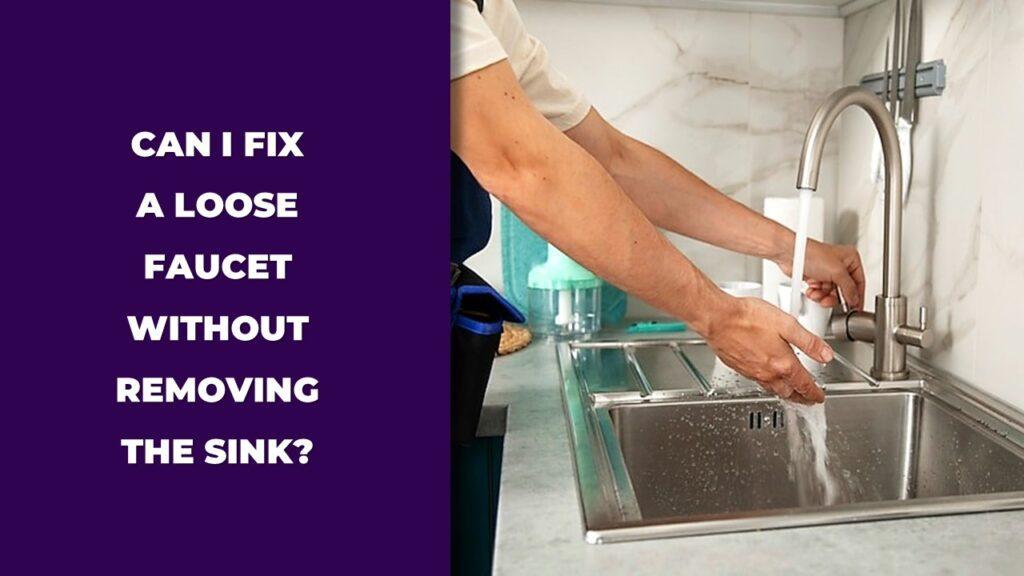
Yes, you can fix a loose faucet without taking out the sink. Usually, it’s just a loose nut under the sink or a wobbly handle screw. A wrench or screwdriver is all you really need, and maybe a bit of patience if space is tight.
In this article, I’ll walk you through what causes a faucet to get loose, how to tighten it step by step, and what tools help the most. I’ll also share tips to keep it tight and when you might want to call a plumber. Let’s make this easy.
Why Does a Faucet Become Loose?
A faucet becomes loose because stuff shifts and wears out over time. The nut under the sink that holds it tight can work itself loose. Same goes for the little set screw inside the handle—it can wiggle loose after lots of use. O-rings or washers inside the faucet can also wear down and stop holding things the way they should. That’s pretty much what causes it.
Main Causes
- The nut under the sink is loose.
- The set screw inside the handle isn’t tight anymore.
- The O-rings or washers are old, cracked, or just worn out.
- Pipes move around a bit when the water’s turned on and off, which can loosen connections.
Risks of Ignoring the Issue
- A small leak can show up under the sink, and that can cause damage over time.
- Loose faucets can make your water bill creep up if they start dripping.
- If the faucet stays loose too long, it might get worse and cause bigger plumbing problems.
- Worst case, it could just come off in your hand one day—nobody wants that.
Can You Really Fix a Loose Faucet Without Removing the Sink?
Yes, you can. Most of the time, you don’t need to pull out the whole sink to fix a loose faucet. It’s usually just a matter of tightening the nut under the sink or the set screw inside the handle. You’ll need a few basic tools, but that’s it.
Situations Where You Can Fix It Without Removal
- The mounting nut is loose and easy to reach.
- The handle screw is loose and you can tighten it with an Allen wrench or screwdriver.
- The spout is wobbly, and you can fix it by replacing an O-ring.
- The faucet isn’t damaged, and there’s no heavy corrosion or rust getting in the way.
Situations Where You Might Need to Remove the Sink
- The nut under the sink is so rusted or stripped that you can’t get it off.
- There’s no space for a wrench under the sink, and you just can’t reach it.
- The faucet is part of a larger, built-in setup that blocks access.
- You’ve tightened everything you can, and the faucet is still loose or leaking.
Tools You’ll Need for the Job
You don’t need a ton of tools for this. Just a few basics can get it done.
- Adjustable wrench (for nuts under the sink).
- Basin wrench (this is a must if the space under your sink is tight).
- Allen wrench (for those little set screws on handles).
- Flathead and Phillips screwdrivers (for prying off caps or tightening screws).
- Flashlight (you’ll want to see what you’re doing under there).
- Plumber’s tape (helps keep things tight and prevents leaks).
- Optional: Thread sealant (if you want a little extra grip on threads).
That’s it. Nothing fancy. Just a few simple tools and a bit of patience.
Step-by-Step Guide: How to Fix a Loose Faucet Without Removing the Sink
Here’s the step-by-step way to fix a loose faucet without having to take out the sink:
- Shut off the water so you don’t end up with a mess.
- Make space under the sink so you can actually move around.
- Figure out what’s loose—the base, the handle, or the spout.
- Tighten the mounting nut under the sink if the whole thing wobbles.
- Tighten the set screw in the handle if that’s the issue.
- Check the spout—if it wiggles, look at the O-rings.
- Turn the water back on and make sure nothing’s leaking.
Alright, let’s break it down one step at a time.
Step 1: Turn Off the Water Supply
This is the part people forget, and then they get a face full of water. Look under the sink, find the little shut-off valves, and turn them to the right. Both hot and cold, just to be safe. Then open the faucet to drain out any leftover water. Now you’re ready.
Step 2: Clear Space Under the Sink
You’re gonna need some space, so pull out the trash can, the cleaning stuff, whatever’s crammed in there. You’ll need to lay down or at least crouch to get in and see the parts. A flashlight or even your phone’s light can help a ton here.
Step 3: Identify the Type of Faucet Problem
Not all wobbles are the same. Here’s how to tell:
- Loose Faucet Base: The whole faucet moves when you touch it.
- Loose Faucet Handle: The handle wiggles side to side when you turn it.
- Loose Spout: The spout lifts up a bit or feels wobbly when you move it.
Knowing which part is loose helps you fix the right thing.
Step 4: Fixing a Loose Faucet Base (Mounting Nut Method)
Slide under the sink, look up, and find the big nut holding the faucet in place. It’s usually right where the faucet meets the sink. Use a basin wrench (trust me, it’s way easier than a regular wrench) and turn it to the right. Get it snug, but don’t go overboard. If you have plumber’s tape, wrapping a bit around the threads before tightening can help keep it from loosening again.
Step 5: Fixing a Loose Faucet Handle (Set Screw Method)
Look for a little cap on the handle or somewhere near the base. Pop that off—sometimes you need a flathead screwdriver for this. Inside, there’s a small set screw. Use an Allen wrench or screwdriver (depends on the faucet) and turn it tight. Put the cap back on, and you should be good.
Step 6: Fixing a Loose Faucet Spout (If Applicable)
If your faucet spout lifts off, pull it straight up. Check the rubber O-rings underneath. If they look cracked or worn, swap them out for new ones. Add a little plumber’s grease if you have it, and slide the spout back on. That should fix the wobbly spout.
Step 7: Final Checks and Leak Testing
Turn the water back on slowly. Watch for any leaks around the base, handle, or spout. Give the faucet a little wiggle—if it’s solid, you nailed it. If it’s still loose, don’t worry—we’ll talk troubleshooting next.
Troubleshooting: What If the Faucet Still Feels Loose?
If you’ve done all the steps and the faucet still feels wobbly, there’s probably something else going on. Maybe the nut is stripped or the threads are worn out—no matter how much you tighten it, it won’t stay tight. That happens. Sometimes you just need to swap out the nut or other parts.
Another thing—it could be the faucet itself. If it’s old, the parts inside might just be done. No amount of tightening will make it work right. At that point, you might want to think about replacing it.
Sometimes the problem isn’t the faucet at all. Maybe the sink is just too tight to get tools in there properly. If you can’t even reach the nut, it’s tough to fix. That’s when you might need to call a plumber—someone who’s got the right tools and knows their way around cramped spaces.
And hey, don’t feel bad if you can’t get it perfect. Some faucets are just a pain. You gave it your best shot, and sometimes that’s all you can do.
Preventative Maintenance Tips
If you want to keep your faucet from getting loose again, you really just need to keep an eye on it once in a while. That’s it. Every few months, give the faucet a little wiggle. If it starts to feel loose, tighten it before it turns into a bigger problem. It doesn’t have to be a big project.
When you’re under the sink, check the mounting nut. It can loosen over time just from using the faucet every day. A quick half-turn with a wrench now and then can save you from leaks or water damage later.
Another thing people forget—wipe down your faucet regularly. If you see white, chalky stuff building up around the base, that’s hard water minerals, and it can mess with the threads and seals. Just use a soft cloth, some dish soap, and give it a wipe every week or so.
If you’ve got a faucet with O-rings—like a pull-out or swivel spout—those little rubber rings dry out. You don’t have to be a plumber to handle it. A dab of plumber’s grease now and then will keep things moving smooth and help prevent leaks down the line.
When to Call a Professional Plumber
If you’ve tried all the tricks—tightened the nut, checked the handle, cleaned the spout—and it’s still loose, yeah, it might be time to call in a pro. Some things just won’t budge no matter how much you tighten, and that’s when you know you’re dealing with something that needs a plumber’s tools and know-how.
Sometimes the parts are so old, rusty, or stripped that no amount of tightening will help. A plumber can figure that out pretty quickly and save you hours of frustration.
Or maybe your faucet’s a fancy model, like a touchless one or some high-end design. Those can be tricky, with extra parts that are hard to reach or even special tools required. It’s not a bad thing to call someone who’s done it a hundred times before.
And let’s be honest, sometimes it’s just worth it for your peace of mind. If you’re feeling stuck, don’t beat yourself up. A plumber can knock it out fast and save you from breaking something or making it worse. It’s not a failure—it’s smart to ask for help when you need it.
Conclusion
Fixing a loose faucet without removing the sink is totally doable. Most of the time, it’s just a matter of grabbing a wrench and tightening the nut or set screw. Whether it’s a wobbly base, a loose handle, or a spout that lifts up when you don’t want it to, the steps are pretty straightforward.
If you’ve followed this guide and still can’t get the faucet to stay put, it might be time to call in a plumber. And hey, no shame in that—some jobs need a pro. Just remember to check your faucet every few months, wipe away mineral buildup, and keep an eye on the nuts and screws. It’ll help your faucet stay tight and working like it should.
Don’t stress too much—this is the kind of fix most people can handle with a little patience, the right tools, and maybe a bit of crawling under the sink.
Related FAQs
Can I fix a loose faucet with just basic tools?
Yes, you usually just need a wrench, screwdriver, and an Allen key.
How tight should I make the mounting nut?
Tight enough so the faucet doesn’t move, but don’t go overboard—too tight can crack the sink.
Can I use plumber’s tape to prevent the faucet from loosening again?
Yes, a few wraps of plumber’s tape can help the threads grip better and stop loosening.
What if I can’t reach the nut under the sink?
That’s what a basin wrench is for. It’s made for tight spaces and awkward angles.
How often should I check for a loose faucet?
About every 3 to 6 months, just a quick check when you’re cleaning the sink.

Dylan Foster is a family man with years of hands-on experience in plumbing, household maintenance, and fixing everyday issues around the home. A former plumber, Dylan knows what it’s like to deal with tricky leaks, worn-out parts, and all the little problems that pop up in a house. From plumbing repairs to kitchen fixes and garden hose setups, he’s done it all. Dylan shares real-world solutions to help others keep their homes running smoothly and avoid costly mistakes.




